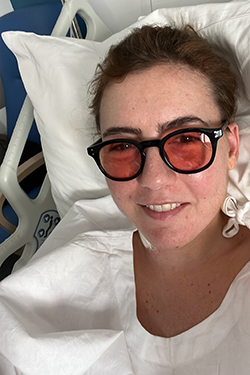For woman with stiff person syndrome, plasma exchange brings relief
As someone who was known as the life of every party and who has a passion for dancing and music, being diagnosed with stiff person syndrome (SPS) was heartbreaking for Lea Jabre.

Jabre, who was living with both type 1 diabetes and endometriosis, noticed new and different symptoms around 2017. They ranged from feeling bloated with difficulty digesting food to an accelerated heartbeat and fainting spells. She was misdiagnosed with irritable bowel syndrome, gastroenteritis, and panic attacks.
Jabre was familiar with panic attacks, having experienced them regularly when getting blood tests because of her fear of needles. Since her symptoms weren’t getting better, Jabre began doing her own research, which eventually led to a diagnosis of postural tachycardia syndrome (PoTS) by a cardiologist specialized in heart rhythm. The PoTS diagnosis explained why she had an elevated heart rate and fainting spells, but her other symptoms–like being in constant pain, dry eyes and mouth, cracking bones, and non-epileptic seizures–were still occurring. She also began experiencing muscle stiffness and spasms.
Five years later, after a long search for a diagnosis, Jabre was finally referred to a specialist in Lebanon who diagnosed her with SPS. The diagnosis was ultimately confirmed when she saw Dr. Scott Newsome at Johns Hopkins Stiff Person Syndrome Center.
SPS is a rare and progressive neurological disease that has autoimmune features. It affects an estimated one person in 1,000,000, most of whom are women. On average, it takes seven years to identify SPS in patients, and it is often misdiagnosed. SPS causes progressive muscle stiffness and severe muscle spasms that lead to chronic pain, falls, and loss of mobility over time.
Those living with SPS can experience muscle spasms so forceful that they dislocate joints or break bones. Eventually, people with SPS may develop hunched postures or become unable to walk or move. They are also more prone to other injuries due to the rigidity they experience trying to use normal reflexes, like catching themselves during a fall.
“When I was first diagnosed, I kind of felt some relief because I finally could put a name to what I was feeling, but when I finally realized what SPS entailed it was very difficult to accept, and took a while to begin having a positive mindset,” said Jabre. “I was 34 and had only been married for two years. I wanted to travel the world and start a family, have babies, and it felt like this was being taken away from me.”
While there is currently no cure for SPS, plasma-based therapies, such as immunoglobulin (Ig) replacement therapy and therapeutic plasma exchange (PLEX), are beneficial and well-tolerated in improving symptoms commonly associated with SPS. For Jabre, PLEX has provided relief where other treatments have failed.
“I hope it keeps giving me what it’s given me the last year, I hope it gives me stability, I hope it gives me joy of life because although I cannot regain what I have lost, it does significantly help me and I have learned to appreciate the small wins,” she said of her PLEX treatments.
“I can’t say it’s giving me back my life, but today we aren’t talking about getting back to normal life because we’re talking about such a hard disease—not one patient is the same.”
Jabre is now actively involved with The Stiff Person Syndrome Research Foundation, where she helps fundraise and will be leading a patient advisory committee. She also helps spread awareness for SPS and PLEX through her Instagram account, @bent_not_broken_autoimmune. “I know that telling my story and sharing my experience will make a difference, even if it’s a small one,” she said.
Help those with stiff person syndrome receive the treatments they need, donate plasma today!
More Heroes

Find a donation center
Donate blood plasma. Be a hero. Locate a plasma donation center near you.

